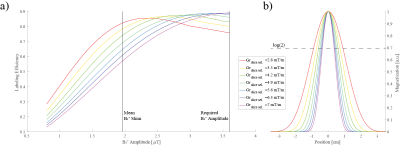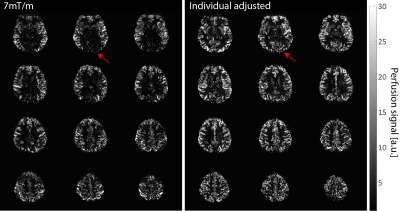Christian R. Meixner1, Sebastian Schmitter2,3, Jürgen Herrler4, Arnd Dörfler4, Michael Uder1, and Armin M. Nagel1,3
1Institute of Radiology, University Hospital Erlangen, Friedrich-Alexander-Universität Erlangen-Nürnberg, Erlangen, Germany, 2Physikalisch-Technische Bundesanstalt (PTB), Braunschweig und Berlin, Germany, 3Division of Medical Physics in Radiology, German Cancer Research Center (DKFZ), Heidelberg, Germany, 4Institute of Neuro-Radiology, Friedrich-Alexander Universität Erlangen-Nürnberg, Erlangen, Germany
1Institute of Radiology, University Hospital Erlangen, Friedrich-Alexander-Universität Erlangen-Nürnberg, Erlangen, Germany, 2Physikalisch-Technische Bundesanstalt (PTB), Braunschweig und Berlin, Germany, 3Division of Medical Physics in Radiology, German Cancer Research Center (DKFZ), Heidelberg, Germany, 4Institute of Neuro-Radiology, Friedrich-Alexander Universität Erlangen-Nürnberg, Erlangen, Germany
With lower slice-selective gradient
amplitude of the pcASL labeling – exploiting B1+-phase
shim and Variable-Rate Selective Excitation – the temporal signal-to-noise
ratio of perfusion images can be improved at 7T under suboptimal B1+
conditions.

Figure 3:
Simulation results: a) labeling efficiencies of the different slice selective
gradients and B1+ amplitudes, as well as the mean B1+
amplitude of the 5 subjects after shimming and the required B1+
amplitude. b)
normalized labeling slice profiles of the
different slice selective gradients: with lower gradient amplitude the labeling
slice gets thicker and vice versa.

